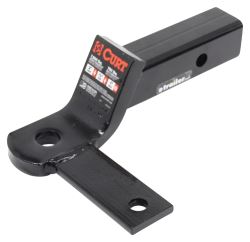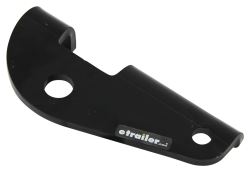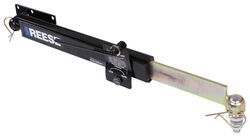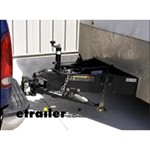
Adding Pro-Series Sway Control, part # 83660, to 1999 Coleman Santee Pop-Up Camper
Question:
I am in need of a friction sway control for the left or drivers side of a used RV that I bought. I see that some say they can be used for both sides, but I dont see how that is possible unlless you take it apart and reverse some parts! My RV is a 1999 Coleman Santee pop up camper and it came with the sway bar ball already mounted on the drivers side of the tongue. Thanks!
asked by: Lisa
Expert Reply:
A friction sway control system can be applied to one or both sides of a trailer frame. We generally recommend using two friction sway units for trailers 26 feet or longer. Your Santee is just under 22 feet in length (with a dry weight of 1700 lbs) so you certainly have the option to use just one sway control arm.
Depending on what vehicle you are using to tow the Santee, you may also benefit from a weight distribution system and many such systems are available with built-in sway control. If you wish to provide specifics about your tow vehicle I can make a recommendation if a WD system is called for.
We suggest a WD system when any of the following conditions exist: 1) your trailer weight (GTW) is more than 50 percent of your tow vehicle weight (GVWR); 2) the rear of your tow vehicle sags when the trailer is hooked up; 3) you experience trailer sway; 4) your tow vehicle headlights point upward; 5) you find it difficult to steer or stop your rig; or 6) you want to tow to the highest capacity allowed by your vehicle trailer hitch setup. If none of these conditions apply then you can probably get by without a WD system. I have included a link to a FAQ article on WD and Sway Control systems that you may want to review.
Please note that your tow vehicles hitch must be rated for use with a WD system in order to use one; you may be able to check this on the hitch itself or with the vehicle manufacturer if it is an OEM factory-installed hitch.
The Reese Friction Sway Control Kit, part # 83660, can be used on either side of your trailer frame. You will need a sway control bracket, part # RP26003, if your tow vehicle draw bar does not have one. This bracket mounts to your draw bar and is held in place by the hitch ball. It provides a place to mount the sway control ball. Once installed on the draw bar, the sway bar ball mount hole will be on the passenger side. If you want to mount the sway bar on the driver side, you will use a weld on tab like part # 3442 instead of the sway control bracket. This must be welded to the side of your ball mount. I have included a video link for this item that shows how it installs. However, since the Reese kit includes a ball plate (the part that mounts to your trailer frame) using the new one is recommended so that all parts are new. This sway control system requires a distance between the tow hitch ball and trailer-mounted sway control ball of 24 inches. This is shown in the video.
If you prefer you can instead use a ball mount that includes a sway control bracket, such as Curt part # D320, which can be used in either rise or drop position, to place the sway ball mount where you need it.
Please note that a sway control system such as the Reese # 83660 should be disengaged when reversing or driving on slick or icy pavement to avoid damage to the sway control arm or loss of control of the tow vehicle.

Products Referenced in This Question
Curt Ball Mount w/ Sway Control Tab for 2" Hitches - 3/4" Rise, 2" Drop - 7,500 lbs
- Trailer Hitch Ball Mount
- Fixed Ball Mount
- No Ball
- 1 Inch Ball Hole Diameter
- Steel Shank - Gloss Black
- Drop - 2 Inch
- Rise - 1 Inch
- Fits 2 Inch Hitch
- 7500 lbs GTW
- Class III
- CURT
more information >
Reese Sway-Control Bracket for 2" Ball Mounts - Class III and IV
- Accessories and Parts
- Weight Distribution Hitch
- Adapters
- Sway Control Parts
- Brackets
- Reese
more information >
Product Page this Question was Asked From
Reese Friction Sway Control Kit - Economy - by Draw-Tite, Reese and Hidden Hitch
- Accessories and Parts
- Weight Distribution Hitch
- Sway Control Parts
- Reese
more information >
Featured Help Information
Instructions
Miscellaneous Media

Continue Researching
- Shop: Reese Friction Sway Control Kit - Economy - by Draw-Tite, Reese and Hidden Hitch
- Q&A: How to Install Pro Series Friction Sway Control on the Left Side of a Trailer
- Video: Reese Friction Sway Control Kit Review
- Shop: Front Mount Hitch
- Article: Which Sway Control Hitch is Right For Your Trailer?
- Article: 5 Things to Know About Weight Distribution Hitches
- Article: How to Measure for Trailer Hitch Drop
- Article: Steel vs. Aluminum Ball Mounts
- Q&A: Can Sway Control be Used on a Trailer without Using Weight Distribution
- Q&A: Should 1 or 2 Bar-Style Friction Sway Control Units be Used on a 7,000 Pound Trailer
- Q&A: Recommended Weight Distribution System for a 3,500 lbs Trailer
- Q&A: Availability Of TLC65 Trimax Trailer Wheel Chock and Lock With A23456 Keys
- Article: Determining Trailer Tongue Weight
- Q&A: What Towing Mirror Extensions Will Fit My 2022 Toyota Tundra Limited?
- Article: How to Choose the Right Trailer Hitch Class
- Article: Ball Mount Basics: Weight Capacity, Class, and Size
- Q&A: Parts Needed to Add Brake Controller to 2024 Toyota Sienna Platinum









